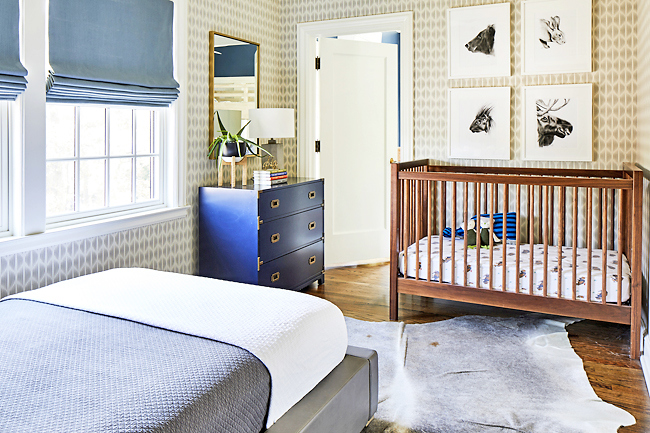Vaishnavi Nayel Talawadekar
THE WASHINGTON POST – Soon after I became pregnant with my second child, I realised we had no room for a dedicated nursery. We were two years into the pandemic, and the guest bedroom was masquerading as my husband’s office. The living room had morphed into a makeshift playroom. And my two-year-old son’s nursery was doubling as a guest room.
Because of the lack of space – and my experience with my impossibly nocturnal first child – I decided I should just keep my baby at arm’s length, so I decided to create a nursery corner in the main bedroom. I didn’t want to spend a lot of money on this, though, or make any big structural changes; I knew the baby would quickly outgrow the space. So we turned the wall opposite our bed into a nifty nursery nook.
After more than a year of living with it, I can say it was one of the best decisions I’ve ever made.
If, like me, you have been pondering ways to add a nursery corner to your bedroom but aren’t sure of where to start, we have you covered. We spoke with some designers about easy, budget-friendly ways to decorate a temporary space for your baby. Here are their suggestions:
Pick a consistent palette. If your bedroom was neutral before your baby came along, stick with that colour scheme. By honouring the existing palette, you can make the nursery a seamless extension of your bedroom. “In a muted room, you can dial up the pizazz with colourful accents and dreamy prints, patterns and textures on bedcovers, blankets and rugs,” said designer of Tulsa-based Mel Bean Interiors Mel Bean.
Go big with accents. Accessories are a great way to decorate a short-lived space, because they can be put up and removed quickly. Bring in dreamcatchers, whimsical decals, lamps and art that delineate that part of the room as being dedicated to the baby. Bean also suggests using peel-and-stick wallpaper in kid-friendly designs to highlight the nook. “Wallpaper on an accent wall can be an absolute showstopper.”

You could even channel your creative side by introducing decorative elements to suit the season – and your baby’s developmental stages – such as an LED lamp mobile, a tinsel crib skirt, or a pressed-flower potpourri pouch tied to the bottom of the crib for summer.
Founder and principal designer of Mumbai-based Essajees Atelier Sarah Sham recommended adding a natural touch. “Plants are a nice, natural way to bring in the outdoors, and they … pack a visual punch, too,” she said. They are the perfect way to add interest without making the room look too juvenile for a shared space.
Look for multitasking furniture. Remember: Your baby will quickly outgrow this space – and the furniture – so it makes sense to opt for multitasking pieces, such as removable shelves, cribs with drawers, compact storage ottomans, bassinets that double as storage baskets and nursing chairs that can be used as accents. “A contemporary and convertible baby crib can dovetail nicely with the … aesthetic and be turned into a bed when your child is old enough to graduate to their own room,” Sham said. Bean suggested using your dresser as a changing table to get the most mileage out of the pieces you already own.
Plan your storage. Look for solutions that are big on storage but small on size. Hanging shelves, wall hooks, over-the-door hangers and wall organisers, for example, are excellent ways to make use of vertical space. Founder of Austin-based Kim Lewis Designs Kim Lewis, also suggests updating your closet. “Adding a second rod can be a quick, convenient way to double your closet’s capacity,” she said. “You can do this by attaching a new rod to the existing one with a lightweight chain and using carabiners, S-hooks or screw eyes to secure the system in place.”
Rolling carts can be used to hold diapers, creams, washcloths and blankets, and the carts can be stowed when not in use. And make the most of under-crib space by filling it with storage cubes and baskets to hold sheets, mattress protectors and other non-daily-use items.
Tailor your lighting. What works for adults in a main bedroom might not be the best fit for babies, so adjust your lighting accordingly. Sham recommended using soft lighting with a dimmer instead of an on-off switch.
“Often, when babies wake, you want to be able to have a light that goes from bright to dim, or at least provide ambient cover,” she said. “Soft lighting can minimise the contrast between light and dark and thereby prevent overstimulation.”
Sham also said to avoid halogen lights and exposed bulbs. Go with diffused or shaded light, and use soft-white or daylight bulbs. Placement also matters. “Some types of bulbs are prone to overheating, so if you are using them, it’s important to keep them out of reach of your little one,” she said.
And layer your lighting, so you have options for different tasks. “A single source of bright light may be overwhelming for a baby with underdeveloped eyes, so it’s a good idea to have at least three light sources to illuminate the room as required,” Sham said.
“For example, a ceiling fixture, a bedside lamp and a changing-table light could work independently or together to give you enough light where you need it.”







